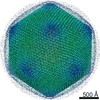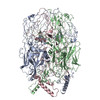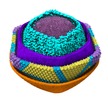+ Open data
Open data
- Basic information
Basic information
| Entry | Database: EMDB / ID: EMD-0815 | |||||||||
|---|---|---|---|---|---|---|---|---|---|---|
| Title | African Swine Fever Virus | |||||||||
 Map data Map data | African Swine Fever Viron | |||||||||
 Sample Sample |
| |||||||||
| Biological species |   African swine fever virus African swine fever virus | |||||||||
| Method | single particle reconstruction / cryo EM / Resolution: 8.8 Å | |||||||||
 Authors Authors | Wang X / Wang N | |||||||||
 Citation Citation |  Journal: Science / Year: 2019 Journal: Science / Year: 2019Title: Architecture of African swine fever virus and implications for viral assembly. Authors: Nan Wang / Dongming Zhao / Jialing Wang / Yangling Zhang / Ming Wang / Yan Gao / Fang Li / Jingfei Wang / Zhigao Bu / Zihe Rao / Xiangxi Wang /  Abstract: African swine fever virus (ASFV) is a giant and complex DNA virus that causes a highly contagious and often lethal swine disease for which no vaccine is available. Using an optimized image ...African swine fever virus (ASFV) is a giant and complex DNA virus that causes a highly contagious and often lethal swine disease for which no vaccine is available. Using an optimized image reconstruction strategy, we solved the ASFV capsid structure up to 4.1 angstroms, which is built from 17,280 proteins, including one major (p72) and four minor (M1249L, p17, p49, and H240R) capsid proteins organized into pentasymmetrons and trisymmetrons. The atomic structure of the p72 protein informs putative conformational epitopes, distinguishing ASFV from other nucleocytoplasmic large DNA viruses. The minor capsid proteins form a complicated network below the outer capsid shell, stabilizing the capsid by holding adjacent capsomers together. Acting as core organizers, 100-nanometer-long M1249L proteins run along each edge of the trisymmetrons that bridge two neighboring pentasymmetrons and form extensive intermolecular networks with other capsid proteins, driving the formation of the capsid framework. These structural details unveil the basis of capsid stability and assembly, opening up new avenues for African swine fever vaccine development. | |||||||||
| History |
|
- Structure visualization
Structure visualization
| Movie |
 Movie viewer Movie viewer |
|---|---|
| Structure viewer | EM map:  SurfView SurfView Molmil Molmil Jmol/JSmol Jmol/JSmol |
| Supplemental images |
- Downloads & links
Downloads & links
-EMDB archive
| Map data |  emd_0815.map.gz emd_0815.map.gz | 5.3 GB |  EMDB map data format EMDB map data format | |
|---|---|---|---|---|
| Header (meta data) |  emd-0815-v30.xml emd-0815-v30.xml emd-0815.xml emd-0815.xml | 7.4 KB 7.4 KB | Display Display |  EMDB header EMDB header |
| Images |  emd_0815.png emd_0815.png | 219.7 KB | ||
| Archive directory |  http://ftp.pdbj.org/pub/emdb/structures/EMD-0815 http://ftp.pdbj.org/pub/emdb/structures/EMD-0815 ftp://ftp.pdbj.org/pub/emdb/structures/EMD-0815 ftp://ftp.pdbj.org/pub/emdb/structures/EMD-0815 | HTTPS FTP |
-Validation report
| Summary document |  emd_0815_validation.pdf.gz emd_0815_validation.pdf.gz | 78.8 KB | Display |  EMDB validaton report EMDB validaton report |
|---|---|---|---|---|
| Full document |  emd_0815_full_validation.pdf.gz emd_0815_full_validation.pdf.gz | 78 KB | Display | |
| Data in XML |  emd_0815_validation.xml.gz emd_0815_validation.xml.gz | 493 B | Display | |
| Arichive directory |  https://ftp.pdbj.org/pub/emdb/validation_reports/EMD-0815 https://ftp.pdbj.org/pub/emdb/validation_reports/EMD-0815 ftp://ftp.pdbj.org/pub/emdb/validation_reports/EMD-0815 ftp://ftp.pdbj.org/pub/emdb/validation_reports/EMD-0815 | HTTPS FTP |
-Related structure data
| Related structure data |  0810C  0811C  0812C  0813C  0814C  6l2tC C: citing same article ( |
|---|---|
| Similar structure data |
- Links
Links
| EMDB pages |  EMDB (EBI/PDBe) / EMDB (EBI/PDBe) /  EMDataResource EMDataResource |
|---|
- Map
Map
| File |  Download / File: emd_0815.map.gz / Format: CCP4 / Size: 5.7 GB / Type: IMAGE STORED AS FLOATING POINT NUMBER (4 BYTES) Download / File: emd_0815.map.gz / Format: CCP4 / Size: 5.7 GB / Type: IMAGE STORED AS FLOATING POINT NUMBER (4 BYTES) | ||||||||||||||||||||||||||||||||||||||||||||||||||||||||||||
|---|---|---|---|---|---|---|---|---|---|---|---|---|---|---|---|---|---|---|---|---|---|---|---|---|---|---|---|---|---|---|---|---|---|---|---|---|---|---|---|---|---|---|---|---|---|---|---|---|---|---|---|---|---|---|---|---|---|---|---|---|---|
| Annotation | African Swine Fever Viron | ||||||||||||||||||||||||||||||||||||||||||||||||||||||||||||
| Projections & slices | Image control
Images are generated by Spider. | ||||||||||||||||||||||||||||||||||||||||||||||||||||||||||||
| Voxel size | X=Y=Z: 2.68 Å | ||||||||||||||||||||||||||||||||||||||||||||||||||||||||||||
| Density |
| ||||||||||||||||||||||||||||||||||||||||||||||||||||||||||||
| Symmetry | Space group: 1 | ||||||||||||||||||||||||||||||||||||||||||||||||||||||||||||
| Details | EMDB XML:
CCP4 map header:
| ||||||||||||||||||||||||||||||||||||||||||||||||||||||||||||
-Supplemental data
- Sample components
Sample components
-Entire : African swine fever virus
| Entire | Name:   African swine fever virus African swine fever virus |
|---|---|
| Components |
|
-Supramolecule #1: African swine fever virus
| Supramolecule | Name: African swine fever virus / type: virus / ID: 1 / Parent: 0 / NCBI-ID: 10497 / Sci species name: African swine fever virus / Virus type: VIRION / Virus isolate: SPECIES / Virus enveloped: Yes / Virus empty: No |
|---|
-Experimental details
-Structure determination
| Method | cryo EM |
|---|---|
 Processing Processing | single particle reconstruction |
| Aggregation state | particle |
- Sample preparation
Sample preparation
| Buffer | pH: 7 |
|---|---|
| Vitrification | Cryogen name: ETHANE |
- Electron microscopy
Electron microscopy
| Microscope | FEI TITAN KRIOS |
|---|---|
| Image recording | Film or detector model: GATAN K2 QUANTUM (4k x 4k) / Average electron dose: 35.0 e/Å2 |
| Electron beam | Acceleration voltage: 300 kV / Electron source:  FIELD EMISSION GUN FIELD EMISSION GUN |
| Electron optics | Illumination mode: FLOOD BEAM / Imaging mode: BRIGHT FIELD |
| Experimental equipment |  Model: Titan Krios / Image courtesy: FEI Company |
- Image processing
Image processing
| Final reconstruction | Resolution.type: BY AUTHOR / Resolution: 8.8 Å / Resolution method: FSC 0.143 CUT-OFF / Number images used: 43811 |
|---|---|
| Initial angle assignment | Type: MAXIMUM LIKELIHOOD |
| Final angle assignment | Type: MAXIMUM LIKELIHOOD |
 Movie
Movie Controller
Controller









 Z (Sec.)
Z (Sec.) Y (Row.)
Y (Row.) X (Col.)
X (Col.)





















